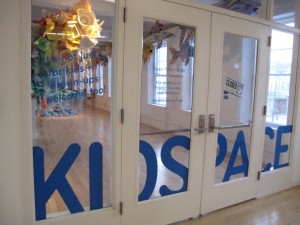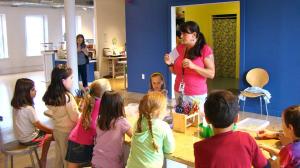
Meg Salocks
Arts Education in Museum Spaces: The Enriching Kidspace at MASS MoCA
Posted by Feb 06, 2015 0 comments

Meg Salocks

If you haven’t heard of it, the Massachusetts Museum of Contemporary Art (MASS MoCA) in North Adams, is well worth a visit – no matter how long it takes to get there. If you have heard of it, then you know what I’m talking about.
 Photo Credit: Meg Salocks
Photo Credit: Meg SalocksOpened in 2000, in a massive factory complex that takes up nearly a third of downtown North Adams, MASS MoCA is a seamless blend of contemporary art, community, and education.
North Adams is located in the general Western Massachusetts region and, in the past 25 years, has unfortunately been subject to significant economic upheaval that left a majority of the population unemployed. While the museum had an understandably rocky start in this setting - trying to convince locals that the arts could indeed revitalize an entire town - in the past 14 years they have achieved exactly that. This slow but steady growth and success is largely thanks to the museum staff’s steadfast commitment to high-quality arts education and to their community.
More specifically, the groundbreaking Kidspace at MASS MoCA, a unique arts and education space, has played a huge role both in the relationship between MASS MoCA and the greater North Adams community - and in developing a sustainable and regular space for arts education for all local K-8 students. How’d they do it? I’m so glad you asked.
School Partnerships, Meet Founding Mission
MASS MoCA was founded on a three-pronged mission that contemporary art, community engagement in that art, and community health are all essential to the museum. Kidspace – the child-centered contemporary art gallery, hands-on studio, and education center of MASS MoCA – was founded around the same time to address a lack of regular high quality arts education opportunities for local K-8 students. It presently occupies its own permanent space in the massive museum complex, and is free for kids and families to stop in and participate in some art-making at the Art Bar every weekend.
 Photo Credit: Kidspace
Photo Credit: KidspaceIn addition to being open to all visitors, from the beginning, Kidspace strove to foster an intensive arts-integration partnership with a couple local K-8 schools. Today they are partnered with six schools across the greater region, and work with many others. These partnerships in particular are powerful, as they require repeating visits to Kidspace over the course of a student’s educational timeline. The education team at MASS MoCA believes that this continuity is key, and complements it with a pedagogy that features inquiry-based tours, art-making activities, and multiple approaches to learning - included guided visualization, and intensely focused discussion. Not only is this a population of students who otherwise would not have had the time or opportunity to afford such visits or classes, but thanks to regular program evaluation, the MASS MoCA Education team know that “by the time they reach high school, these students have had more than a dozen high-quality, deep and extended engagements with new art and living artists.”
 Photo Credit: Kidspace
Photo Credit: KidspaceIt is important to note that the staff at Kidspace have slowly built up their programming, echoing the slow but steady program growth we also see at the Farnsworth Art Museum. As those in the museum education field know, it can be tricky to demonstrate the value hands-on arts learning experiences can have on the greater education of the whole student. While this slows down the entire process of fostering an arts education ecosystem, it also allows for those in museum education to research and prepare the best way to connect other stakeholders. Director of Education and Kidspace, Laura Thompson, was well aware that it would take time before local schools and education leaders to feel buy-in, and committed to proving the program’s value in their language:
We work closely with classroom and art teachers, as well as administrators and coordinators to develop our ideas of exhibitions and programs. We review the schools’ curriculums and even their text books. Through training sessions, we learn more about the specific concerns in the schools and try to shape our programs accordingly.
In sum, MASS MoCA Education staff believe that the arts are something that need to be integrated into everything and continue to push local education leaders and stakeholders to do more and work together to reach a greater span of student - geographically, intellectually, and more.
New Horizons for Arts Integration
When I visited MASS MoCA this past January, one of the first things I noticed was that the icy conditions and midwinter blues could not damper an intense STEAM and arts integration meeting happening in the classroom of Kidspace. If that was not enough to make any arts education advocate leap for joy, I learned of a recent grant that Kidspace had received from the Institute of Museum and Library Sciences that would allow them to expand their school partnerships by instituting a fund to provide transportation from schools to the museum for students and their teachers. The grant also provided additional funds to support programs, pre-visit materials for teachers, and artist residencies for the schools.
Kidspace’s latest focus would be supported through this new funding - to position Kidspace’s educational programming to discuss important social topics through art. MASS MoCA’s Kidspace seeks to use their repeated art-integrated lesson style to give children of all ages the tools to discuss and approach social topics and contemporary issues that young generations face in the future. By combining their expertise in curating thematic exhibits in the Kidspace gallery, and hands-on learning and discussion with students, they will lead students through learning important life skills through the arts, resulting in a final program geared around arts education as a vehicle for applying those skills to solve a larger problem. In short: problem solving through arts education; it’s possible and they’re going to prove it.
Many of us in the arts world already know that arts education can indeed teach students important skills like teamwork, problem-solving, communication, and more – but this educational program proposes to actually create an experience that will yield arts and problem-solving experience measurably for students through regular sessions over the course of four years.
